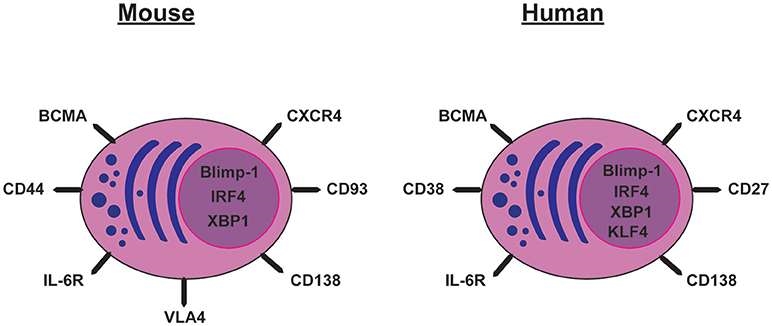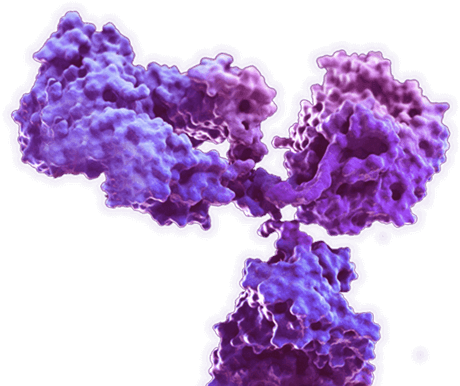Cellular Marker
Supported by in-house scientists and first-class technical platform, Creative Biolabs provides a full range of high-quality cellular marker antibody products and services to facilitate your project success.
Background
Cellular markers are special proteins and carbohydrates attached to the cell membrane. Compared to some proteins that have the function of allowing the transport of molecules across the membrane, cellular markers play a primary role in intercellular communication and recognition. Cellular markers can be used to identify specific cells and monitor cell growth and differentiation. It is also used in the diagnosis and treatment of many diseases.
 Fig. 1 Cell surface markers expressed by mouse and human long-lived plasma cells. (Brynjolfsson, 2018)
Fig. 1 Cell surface markers expressed by mouse and human long-lived plasma cells. (Brynjolfsson, 2018)
Research Area of Cellular Marker in Different Species
- Zebrafish
Previously, zebrafish is not defined as the ideal culture conditions for embryonic stem (ES) cells because the knowledge of pluripotency markers in zebrafish is almost nonexistent. Recently study has shown that stage-specific embryonic antigen 1 (SSEA1) is a marker that precedes the expression of pluripotency genes in a zebrafish embryonic cell colony, in the same way that SOX2 precedes nestin expression in those colonies that have already started differentiation toward neurons, which means a step forward in the knowledge of zebrafish pluripotency markers.
- Rhesus
CD28, CD80, and CD86 are co-stimulatory molecules that are necessary for the proper stimulation of T-cells. Researches have demonstrated that rhesus monkey peripheral B-cells expressed the ligands for CD28, CD80, and CD86. CD80 could be found on about two-thirds of B-cells, the proportion of CD86 expressing cells being slightly lower. The expression level of CD20 on CD80+ B-cells was higher than the one on CD21+ B-cells indicating that these antigens were expressed on different subsets of rhesus monkey peripheral blood B-cells.
- Arabidopsis
The preprophase band (PPB), a cortical ring of microtubules and F-actin, disassembles upon nuclear-envelope breakdown. RanGAP is the GTPase activating protein of the small GTPase Ran, which provides spatial information for nucleocytoplasmic transport and various mitotic processes in animals. Researches have shown that Arabidopsis RanGAP, a continuous positive protein marker of the plant division plane, has a role in spatial signaling during plant cell division.
Reference
- Brynjolfsson, S.F.; et al. Long-Lived Plasma Cells in Mice and Men. Front Immunol. 2018, 9: 2673.
Our provided featured target antibody products including but not limited to:
AibGenesis™ Mouse Anti-Zebrafish ZN3 Antibody (CBMOAB-00236FYA) (CAT#: CBMOAB-00236FYA)
-
- Host species: Mouse
- Species Reactivity: Zebrafish (Danio rerio)
- Application: IHC
- Size: 0.5mg, 1mg, Accordingtothelot.
- Conjugate: AP, APC, Biotin, Consult us more, Cy3, Cy5, Cy5.5, Cy7, FITC, HRP, None, PE, PerCP
- Alternative Names: ZN3
AibGenesis™ Rabbit Anti-BPI Antibody (CBMOAB-00290FYA) (CAT#: CBMOAB-00290FYA)
-
- Host species: Rabbit
- Species Reactivity: Human (Homo sapiens), Zebrafish (Danio rerio), Cattle (Bos taurus), Chimpanzee (Pan troglodytes), Frog (Xenopus laevis), Goat (Capra hircus), Pig (Sus scrofa), Rabbit (Oryctolagus cuniculus), Rhesus (Macaca mulatta)
- Application: WB, FC
- Size: 0.5mg, 1mg, 100µg, 50µg
- Conjugate: AP, APC, Biotin, Consult us more, Cy3, Cy5, Cy5.5, Cy7, FITC, HRP, None, PE, PerCP
- Alternative Names: Bactericidal/Permeability-Increasing Protein, BPI Fold Containing Family D, Member 1, CAP 57, Bactericidal Permeability-Increasing Protein, Recombinant BPI Holoprotein, RBPI, BPIFD1, RBPI
AibGenesis™ Mouse Anti-FLS2 Antibody (CBMOAB-33404FYC) (CAT#: CBMOAB-33404FYC)
-
- Host species: Mouse
- Species Reactivity: A. thaliana (Arabidopsis thaliana), Arabidopsis, Arabidopsis (Arabidopsis lyrata), Grape (Vitis vinifera)
- Application: WB, ELISA
- Protein: LRR receptor-like serine/threonine-protein kinase FLS2
- Size: 0.5mg, 1mg, 200µg
- Conjugate: AP, APC, Biotin, Consult us more, Cy3, Cy5, Cy5.5, Cy7, FITC, HRP, None, PE, PerCP
- Alternative Names: LRR receptor-like serine/threonine-protein kinase FLS2, EC 2.7.11.1, Protein FLAGELLIN-SENSING 2, Protein FLAGELLIN-SENSITIVE 2, FLS2, At5g46330
AibGenesis™ Mouse Anti-RANGAP1 Antibody (CBMOAB-39813FYC) (CAT#: CBMOAB-39813FYC)
-
- Host species: Mouse
- Species Reactivity: A. thaliana (Arabidopsis thaliana), Cattle (Bos taurus), Chimpanzee (Pan troglodytes), Frog (Xenopus laevis), Marmoset, Purple sea urchin (Strongylocentrotus purpuratus), Rhesus (Macaca mulatta)
- Application: WB, ELISA
- Protein: RAN GTPase-activating protein 1
- Size: 0.5mg, 1mg, 200µg
- Conjugate: AP, APC, Biotin, Consult us more, Cy3, Cy5, Cy5.5, Cy7, FITC, HRP, None, PE, PerCP
- Alternative Names: Ran GTPase Activating Protein 1, SD, Segregation Distorter Homolog (Drosophila), Ran GTPase-Activating Protein 1, Segregation Distorter Homolog, Segregation Distortion
AibGenesis™ Anti-NUP107 Antibody (Cat MO-MMB-0548), Mouse IgG1 (CAT#: MO-MMB-0548)
-
- Host species: Mouse
- Species Reactivity: Human (Homo sapiens), Mouse (Mus musculus), Rat (Rattus norvegicus), Yeast, A. thaliana (Arabidopsis thaliana), Fruit fly (Drosophila melanogaster), Rhesus (Macaca mulatta), Marmoset, Zebrafish (Danio rerio)
- Application: ICC, WB
- Protein: Nuclear pore complex protein Nup107
- Size: NONE
- Conjugate: None
- Alternative Names: Nuclear pore complex protein Nup107, 107 kDa nucleoporin, Nucleoporin Nup107, NUP107
AibGenesis™ Anti-FBRL Antibody (Cat MO-MMB-0549), Mouse IgG (CAT#: MO-MMB-0549)
-
- Host species: Mouse
- Species Reactivity: C. elegans (Caenorhabditis elegans), Fruit fly (Drosophila melanogaster), Human (Homo sapiens), Rat (Rattus norvegicus), Yeast
- Application: ICC, WB
- Protein: rRNA 2'-O-methyltransferase fibrillarin
- Size: NONE
- Conjugate: None
- Alternative Names: rRNA 2'-O-methyltransferase fibrillarin, 34 kDa nucleolar scleroderma antigen, FBL, FIB1, FLRN, Nop1p
AibGenesis™ Mouse Anti-Cytokeratin 6 Antibody (MOFY-0522-FY96) (CAT#: MOFY-0522-FY96)
-
- Host species: Mouse
- Species Reactivity: Human, Zebrafish
- Application: IHC, FC
- Protein: Cytokeratin 6
- Size:
- Conjugate:
- Alternative Names: Cytokeratin 6, Keratin K6
To download a Certificate of Analysis, please enter a lot number in the search box below. Note: Certificate of Analysis not available for kit components.
Lot Number

